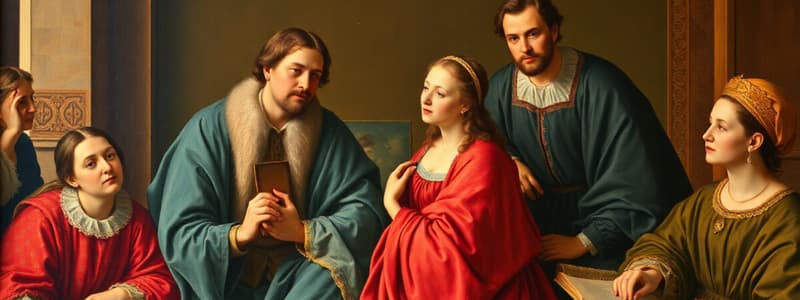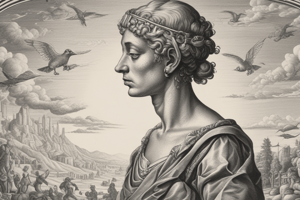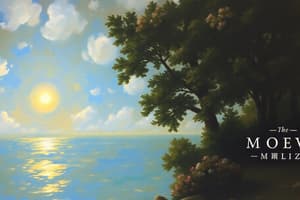Podcast
Questions and Answers
What was a significant social change during the Italian Renaissance?
What was a significant social change during the Italian Renaissance?
- An emphasis on collective societal achievement
- A focus on individual ability and worth (correct)
- A rise in the power of the church over state
- An increase in agricultural production
Which city-states were crucial to Italian politics during the Renaissance?
Which city-states were crucial to Italian politics during the Renaissance?
- Florence, Venice, and Milan (correct)
- Siena, Padua, and Verona
- Rome, Naples, and Bologna
- Turin, Genoa, and Palermo
What characterized the urban society of the Italian Renaissance?
What characterized the urban society of the Italian Renaissance?
- A marked decline in trade and commerce
- A secular or worldly viewpoint gained prominence (correct)
- A focus solely on religious activities and beliefs
- A strict adherence to feudal practices
What was one of the recovery outcomes of the disasters of the 14th century?
What was one of the recovery outcomes of the disasters of the 14th century?
Which of these best describes the view of human beings during the Renaissance?
Which of these best describes the view of human beings during the Renaissance?
Which group of Italians was most directly affected by the Renaissance?
Which group of Italians was most directly affected by the Renaissance?
What theme was commonly depicted in the art of the Italian Renaissance?
What theme was commonly depicted in the art of the Italian Renaissance?
What does the term 'Renaissance' literally translate to?
What does the term 'Renaissance' literally translate to?
What major development in painting did Florentine painters emphasize?
What major development in painting did Florentine painters emphasize?
What was the chief goal of Italian painters during the Renaissance?
What was the chief goal of Italian painters during the Renaissance?
Which architectural style primarily influenced Renaissance architects?
Which architectural style primarily influenced Renaissance architects?
What was Leonardo da Vinci's significant contribution to painting?
What was Leonardo da Vinci's significant contribution to painting?
What did Raphael aim to achieve in his paintings?
What did Raphael aim to achieve in his paintings?
Which medium did Northern artists primarily use for their technique development?
Which medium did Northern artists primarily use for their technique development?
What innovation is Jan van Eyck credited with in painting?
What innovation is Jan van Eyck credited with in painting?
What idea did Albrecht Durer bring to Renaissance art?
What idea did Albrecht Durer bring to Renaissance art?
What characterized El Greco's painting style?
What characterized El Greco's painting style?
What was a significant impact of the Northern Artistic Renaissance?
What was a significant impact of the Northern Artistic Renaissance?
What factors contributed to the prosperity of the Italian city-states?
What factors contributed to the prosperity of the Italian city-states?
What role did the Visconti family play in Milan's history?
What role did the Visconti family play in Milan's history?
What significant change did Francesco Sforza bring to Milan?
What significant change did Francesco Sforza bring to Milan?
How did Venice become an international power?
How did Venice become an international power?
Who controlled Florence during its cultural zenith in the early Renaissance?
Who controlled Florence during its cultural zenith in the early Renaissance?
Why did the citizens support Girolamo Savonarola's movement?
Why did the citizens support Girolamo Savonarola's movement?
What major event marked a turning point in the Italian Wars?
What major event marked a turning point in the Italian Wars?
What is the central thesis of Niccolo Machiavelli's 'The Prince'?
What is the central thesis of Niccolo Machiavelli's 'The Prince'?
What did the ideal noble aspire to achieve?
What did the ideal noble aspire to achieve?
Which group made up the majority of the population during the Renaissance?
Which group made up the majority of the population during the Renaissance?
Who were the patricians in Renaissance society?
Who were the patricians in Renaissance society?
What did the increased competition in the cloth manufacturing industry result in for Florence?
What did the increased competition in the cloth manufacturing industry result in for Florence?
What characterized the government of Venice?
What characterized the government of Venice?
How did the Medici family regain control of Florence?
How did the Medici family regain control of Florence?
What was the most important aspect of the marriage contract in urban families?
What was the most important aspect of the marriage contract in urban families?
What role did the father have in the Italian family structure?
What role did the father have in the Italian family structure?
How did children formally become adults in Italian society?
How did children formally become adults in Italian society?
What characterized the intellectual movement known as humanism during the Renaissance?
What characterized the intellectual movement known as humanism during the Renaissance?
Why is Petrarch referred to as the father of Italian humanism?
Why is Petrarch referred to as the father of Italian humanism?
What significant literary contribution did Dante make to vernacular literature?
What significant literary contribution did Dante make to vernacular literature?
What was Christine de Pizan best known for?
What was Christine de Pizan best known for?
What was the primary aim of humanist education during the Renaissance?
What was the primary aim of humanist education during the Renaissance?
Which aspect was typically the focus of a woman's education in humanist schools?
Which aspect was typically the focus of a woman's education in humanist schools?
What was one of the aims of Renaissance artists in their works?
What was one of the aims of Renaissance artists in their works?
What is a fresco?
What is a fresco?
Who was credited with mastering the laws of perspective in early Renaissance painting?
Who was credited with mastering the laws of perspective in early Renaissance painting?
What did humanist educators emphasize in their teachings besides intellectual subjects?
What did humanist educators emphasize in their teachings besides intellectual subjects?
What distinguishes vernacular literature from classical literature?
What distinguishes vernacular literature from classical literature?
Flashcards
Renaissance
Renaissance
A period (1350-1550) marking a rebirth of ancient cultures in Italy.
Characteristics of Italian Renaissance
Characteristics of Italian Renaissance
Urban society, secular viewpoints, and emphasis on individual ability.
Italian City-States
Italian City-States
Independent regions such as Milan, Venice, and Florence that thrived politically and economically.
Secularism
Secularism
Signup and view all the flashcards
Humanism
Humanism
Signup and view all the flashcards
Leonardo da Vinci
Leonardo da Vinci
Signup and view all the flashcards
Impact on Ordinary Italians
Impact on Ordinary Italians
Signup and view all the flashcards
Recovery from the 14th Century
Recovery from the 14th Century
Signup and view all the flashcards
Milan
Milan
Signup and view all the flashcards
Visconti Family
Visconti Family
Signup and view all the flashcards
Francesco Sforza
Francesco Sforza
Signup and view all the flashcards
Venice
Venice
Signup and view all the flashcards
Doge
Doge
Signup and view all the flashcards
Florence
Florence
Signup and view all the flashcards
Medici Family
Medici Family
Signup and view all the flashcards
Girolamo Savonarola
Girolamo Savonarola
Signup and view all the flashcards
Italian Wars
Italian Wars
Signup and view all the flashcards
Niccolo Machiavelli
Niccolo Machiavelli
Signup and view all the flashcards
Renaissance Society
Renaissance Society
Signup and view all the flashcards
Nobility
Nobility
Signup and view all the flashcards
Third Estate
Third Estate
Signup and view all the flashcards
Patricians
Patricians
Signup and view all the flashcards
Family Security
Family Security
Signup and view all the flashcards
Marriage Contract
Marriage Contract
Signup and view all the flashcards
Father's Role
Father's Role
Signup and view all the flashcards
Child Adulthood
Child Adulthood
Signup and view all the flashcards
Petrarch
Petrarch
Signup and view all the flashcards
Vernacular Literature
Vernacular Literature
Signup and view all the flashcards
Chaucer's Contribution
Chaucer's Contribution
Signup and view all the flashcards
Christine de Pizan
Christine de Pizan
Signup and view all the flashcards
Liberal Studies
Liberal Studies
Signup and view all the flashcards
Aim of Humanist Education
Aim of Humanist Education
Signup and view all the flashcards
Women's Education in Renaissance
Women's Education in Renaissance
Signup and view all the flashcards
Renaissance Art Goals
Renaissance Art Goals
Signup and view all the flashcards
Fresco Technique
Fresco Technique
Signup and view all the flashcards
Perspective in Art
Perspective in Art
Signup and view all the flashcards
Two major developments of Florentine painters
Two major developments of Florentine painters
Signup and view all the flashcards
Chief goal of Italian painters
Chief goal of Italian painters
Signup and view all the flashcards
Influence of classical arts
Influence of classical arts
Signup and view all the flashcards
Brunelleschi's contribution
Brunelleschi's contribution
Signup and view all the flashcards
Leonardo da Vinci's mastery
Leonardo da Vinci's mastery
Signup and view all the flashcards
Raphael's ideal beauty
Raphael's ideal beauty
Signup and view all the flashcards
Michelangelo's ideal type
Michelangelo's ideal type
Signup and view all the flashcards
Northern Renaissance medium
Northern Renaissance medium
Signup and view all the flashcards
Jan van Eyck's innovation
Jan van Eyck's innovation
Signup and view all the flashcards
Durer's introduced idea
Durer's introduced idea
Signup and view all the flashcards
Study Notes
The Renaissance: Rebirth and Change
- The Renaissance, meaning "rebirth," was a period of European history, beginning in Italy and spreading to the rest of Europe.
- Italians believed they were witnessing a rebirth of the ancient Greek and Roman worlds.
- This new age of recovery followed the disasters of the 14th century, including plague, political instability, and decreased church power.
Characteristics of the Italian Renaissance
- Urban Society: Italian city-states were the centers of political, economic, and social life. This led to a secular worldview, fueled by increased wealth.
- Recovery and Rebirth of Interest in Antiquity: The Renaissance was a period of recovery from the 14th-century disasters, accompanied by renewed interest in ancient cultures and a re-evaluation of their own Roman past, including politics and art.
- New View of Human Beings: The Italian Renaissance emphasized individual ability, leading to a new social ideal of a "well-rounded" and capable individual. Leonardo da Vinci's multifaceted talents illustrate this ideal.
- Impact on the Upper Classes: The wealthy upper class embraced the new ideas and activities of the Renaissance more readily.
- Indirect Impact on Ordinary People: While the upper class was significantly impacted, the Renaissance had an indirect effect on ordinary people because of the conspicuous nature of the art and architecture celebrating both religious and secular themes.
The Italian City-States
- Independent City-States: Italy, unlike other parts of Europe, lacked a centralized monarchical state. This led to numerous independent city-states, notably Milan, Venice, and Florence.
- Prosperity through Trade: These city-states thrived due to extensive trade with eastern civilizations (Byzantine and Islamic) and western Mediterranean/Atlantic regions (England and the Netherlands). This involved silk, sugar, spices, and other goods.
Milan
- Key Figures: The Visconti and Sforza families ruled Milan.
- Revenue Generation: Efficient tax systems generated substantial revenue for the government.
Venice
- Description: A major trading city, a republic run by a Doge, with a merchant-aristocratic oligarchy behind the scenes.
- International Power: Its profitable trade empire made Venice an international power.
Florence
- Domination: The powerful Medici family controlled Florence, initially through Cosimo de’ Medici and later Lorenzo de’ Medici. It was the cultural center of Italy at the time.
- Medici Challenge: A Dominican preacher, Girolamo Savonarola, challenged Medici rule and excesses, but was later executed for heresy and the Medicis returned to power.
- Economic Decline: Florence’s manufacturing-based economy, particularly its cloth industry, faced challenges due to increased competition from English and Flemish cloth makers.
The Italian Wars
- Competition: The wealth of the Italian city-states attracted power-hungry European monarchs.
- Conflict: France invaded northern Italy, leading to protracted conflict with Spain.
- Sack of Rome: A turning point in 1527 when Spanish troops sacked Rome, contributing to Spain's dominance in Italy.
Niccolò Machiavelli
- The Prince: Machiavelli's work, The Prince, challenged the ethical approach to political rule prevalent in the Middle Ages.
- Human Nature: He argued that a prince needed to understand human nature's self-centeredness and act accordingly, not being bound by moral constraints.
Renaissance Society
- Three Estates: Renaissance society, like the medieval period, was largely divided into three estates/social classes, with some modifications:
- Nobility (Aristocracy): A small percentage (2-3%), held political posts, and were expected to exhibit specific virtues (born not made, grace, talent, warrior skills, classical education, achievement display with grace).
- Third Estate (Peasants and Townspeople):
- Peasants: Making up the majority, largely free by 1500, and increasingly in various forms of paid labor, less bound to the manor system.
- Townspeople:
- Patricians: Wealthy merchants, bankers, who dominated economically, socially, and politically.
- Burgers: Shopkeepers, artisans, guild members who provided goods and services.
- Workers: Low wages, unemployment, constituting a significant part of the urban population, and faced harsh living conditions.
- Family Security: Family bonds were crucial for security in the urban world. -Marriages were often arranged to strengthen family ties or business, often starting very young.
- Family Structure: The father held primary authority in the family, controlling finances and making decisions about children's lives.
Italian Intellectual and Artistic Renaissance
- Secularism and Humanism: The Renaissance emphasized secularism and the importance of the individual, especially in the arts and intellectual life. Humanism was the study of ancient Greek and Roman culture (classics).
- Petrarch: The "father of Italian humanism," he sought out lost ancient manuscripts and emphasized classical Latin writing.
- Humanist Civic Participation: In early 1400s Florence, humanists actively participated in civic life, serving as secretaries.
- Vernacular Literature: Italian writing of Dante (The Divine Comedy) and Geoffrey Chaucer (The Canterbury Tales) helped popularize vernacular literature.
- Christine de Pizan: A French vernacular writer, de Pizan defended women's ability to learn and intellectual capacity.
Renaissance Education
- Liberal Studies: Humanist schools focused on liberal studies (liberal arts) to help individuals achieve their full potential through rhetoric, wisdom, and virtue.
- Practical Preparation: Education was also seen as practical preparation for civic life.
- Physical Education: Humanist education emphasized physical development.
- Women's Education: Women's education was largely limited to domestic skills and religious instruction, excluding mathematics and rhetoric.
The Artistic Renaissance in Italy
- Two Goals: Renaissance artists aimed to imitate nature in their works and develop a new worldview centered on human beings.
- Techniques:
- Frescoes (painting on wet plaster): Masaccio was a pioneering fresco artist.
- Perspective: Mastering the technique of perspective to portray three-dimensions.
- Developments in Painting: Refinements involving perspective, outdoor space, and light, as well as human anatomy and movement realistically portrayed.
- Sculpture and Architecture: Renaissance sculptors and architects borrowed techniques from classical Greece and Rome, leading to buildings responsive to human needs, notably the Medici-sponsored Church of San Lorenzo by Brunelleschi.
High Renaissance
- Artistic Giants: This era was strongly influenced by three key figures:
- Leonardo da Vinci: A master of realism, using human dissection to perfect realism and move toward idealization in his work
- Raphael: Known for Madonnas and the frescoes in the Vatican Palace, displaying balance, harmony, and order.
- Michelangelo: A painter, sculptor, and architect who developed an ideal human form with perfect proportions reflecting divine beauty.
Northern Artistic Renaissance
- Diffused Ideas: Northern Renaissance artists adapted Italian ideas to their own traditions.
- Different Mediums: Northern artists used wooden panels and book illustrations, distinct from the massive scale of Italian frescos.
- Flemish Center: Flanders became the artistic center of the Northern Renaissance.
- New Techniques: Jan van Eyck pioneered oil paints, creating detail and variety.
- Albrecht Dürer: A German artist who studied Italian techniques and emphasized human proportions in his work.
- El Greco: A Spanish painter influenced by Michelangelo, whose style expressed Spanish religious beliefs through powerful colors and elongated figures.
Studying That Suits You
Use AI to generate personalized quizzes and flashcards to suit your learning preferences.




